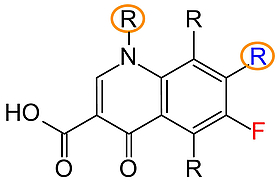New antibiotics that are degradable in the environment
Scientists at the Leuphana University of Lüneburg developed cleavable antibiotics based on fluoroquinolones by targeted changes of the molecular structure. As a result, the environmental degradability can be improved and the antibiotics can be inactivated rapidly after application. The present invention thus enables a balance between degradability in the environment and sufficient stability and efficacy in therapy.
Challenge
Today, water analyzes show that nearly two hundred different pharmaceuticals can be found worldwide in wastewater treatment plants, surface waters, groundwater and also drinking water in concentration ranges up to µg/l (e.g. Ciprofloxacin in waste water of Swiss hospitals between 2-83 µg/l). These impurities result from application in human and animal medicine. They are now perceived as a risk to water quality and a sustainable management of water resources. The use of today's non-degradable antibiotics leads to a steady accumulation in the water. This promotes resistance development when large areas with relevant bacteria are exposed to sufficient concentrations of active ingredients and, in addition, reduces water quality in general.
Our Solution
Scientists at the Leuphana University of Lüneburg developed biodegradable antibiotic variants based on fluoroquinolones by means of targeted molecular structure changes. This can improve the degradability in the environment and can at least neutralize the activity and the toxicity of the metabolites and fragments.
Advantages
- New antibiotic agents for therapy based on known chemical structures (Quinolone antibiotics).
- Environmental relief without loss of efficiency during therapeutic treatment.
- Abiotic and biotic cleavage (neutralization) into inactive metabolites and fragments in the environment.
- This minimizes the risk of resistance formation or resistance promotion in the environment.
- Innovative contribution to Green Pharmacy and Sustainable Development Goals.
Fluoroquinolone backbone. The introduced structural changes (cleavable groups) are marked.
Applications
Sustainable antibiotic therapies through environmentally degradable antibiotics (human and animal health care).
Developmental Status
In vitro feasibility studies of the first test substances based on fluoroquinolones were successfully completed.
Patent Status
DE and EP patent applications were filed (DE102017218114A1, DE102017218119A1, EP3694516A1, EP3694851A1, Applicant : Leuphana University of Lüneburg).
References
- Menz et al. Environ. Pollut. 2017, 231(2):1507-1517: Antimicrobial activity of pharmaceutical cocktails in sewage treatment plant effluent - An experimental and predictive approach to mixture risk assessment.
- Wieck et al. Environ. Int. 2016, 94:695-705: Possible underestimations of risks for the environment due to unregulated emissions of biocides from households to wastewater.
- Rastogi et al. Environ. Sci. Technol. 2015, 49(19):11756-63: Re-Designing of Existing Pharmaceuticals for Environmental Biodegradability: A Tiered Approach with beta-Blocker Propranolol as an Example.
Contact
Dr. Stefan Uhle
Patent Manager Life Science
E-Mail: suhle(at)sciencebridge.de
Tel: +49 551 30724 154
Reference: BioC-2003+2005-ULü
Tags: New compounds

